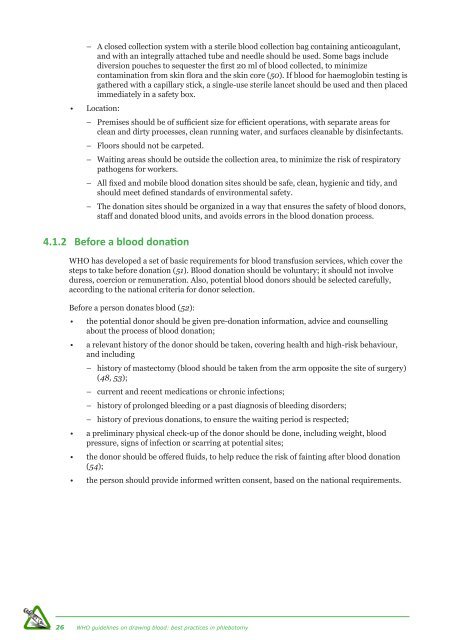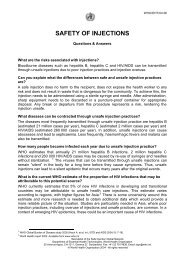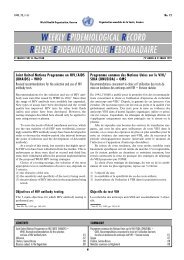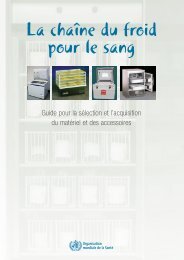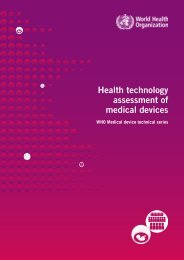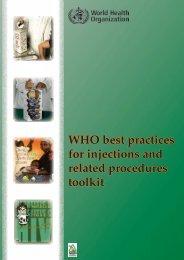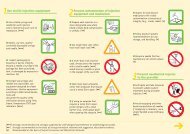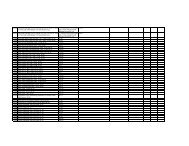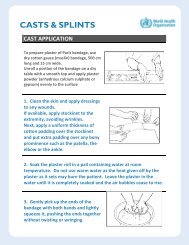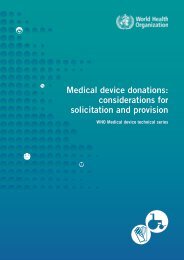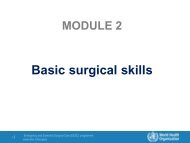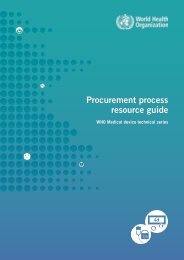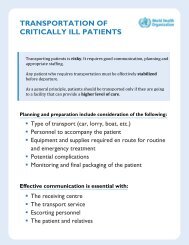WHO Guidelines on Drawing Blood: Best Practices in Phlebotomy
WHO Guidelines on Drawing Blood: Best Practices in Phlebotomy
WHO Guidelines on Drawing Blood: Best Practices in Phlebotomy
- No tags were found...
Create successful ePaper yourself
Turn your PDF publications into a flip-book with our unique Google optimized e-Paper software.
––<br />
A closed collecti<strong>on</strong> system with a sterile blood collecti<strong>on</strong> bag c<strong>on</strong>ta<strong>in</strong><strong>in</strong>g anticoagulant,<br />
and with an <strong>in</strong>tegrally attached tube and needle should be used. Some bags <strong>in</strong>clude<br />
diversi<strong>on</strong> pouches to sequester the first 20 ml of blood collected, to m<strong>in</strong>imize<br />
c<strong>on</strong>tam<strong>in</strong>ati<strong>on</strong> from sk<strong>in</strong> flora and the sk<strong>in</strong> core (50). If blood for haemoglob<strong>in</strong> test<strong>in</strong>g is<br />
gathered with a capillary stick, a s<strong>in</strong>gle-use sterile lancet should be used and then placed<br />
immediately <strong>in</strong> a safety box.<br />
• Locati<strong>on</strong>:<br />
––<br />
Premises should be of sufficient size for efficient operati<strong>on</strong>s, with separate areas for<br />
clean and dirty processes, clean runn<strong>in</strong>g water, and surfaces cleanable by dis<strong>in</strong>fectants.<br />
––<br />
Floors should not be carpeted.<br />
––<br />
Wait<strong>in</strong>g areas should be outside the collecti<strong>on</strong> area, to m<strong>in</strong>imize the risk of respiratory<br />
pathogens for workers.<br />
––<br />
All fixed and mobile blood d<strong>on</strong>ati<strong>on</strong> sites should be safe, clean, hygienic and tidy, and<br />
should meet def<strong>in</strong>ed standards of envir<strong>on</strong>mental safety.<br />
––<br />
The d<strong>on</strong>ati<strong>on</strong> sites should be organized <strong>in</strong> a way that ensures the safety of blood d<strong>on</strong>ors,<br />
staff and d<strong>on</strong>ated blood units, and avoids errors <strong>in</strong> the blood d<strong>on</strong>ati<strong>on</strong> process.<br />
4.1.2 Before a blood d<strong>on</strong>ati<strong>on</strong><br />
<str<strong>on</strong>g>WHO</str<strong>on</strong>g> has developed a set of basic requirements for blood transfusi<strong>on</strong> services, which cover the<br />
steps to take before d<strong>on</strong>ati<strong>on</strong> (51). <strong>Blood</strong> d<strong>on</strong>ati<strong>on</strong> should be voluntary; it should not <strong>in</strong>volve<br />
duress, coerci<strong>on</strong> or remunerati<strong>on</strong>. Also, potential blood d<strong>on</strong>ors should be selected carefully,<br />
accord<strong>in</strong>g to the nati<strong>on</strong>al criteria for d<strong>on</strong>or selecti<strong>on</strong>.<br />
Before a pers<strong>on</strong> d<strong>on</strong>ates blood (52):<br />
• the potential d<strong>on</strong>or should be given pre-d<strong>on</strong>ati<strong>on</strong> <strong>in</strong>formati<strong>on</strong>, advice and counsell<strong>in</strong>g<br />
about the process of blood d<strong>on</strong>ati<strong>on</strong>;<br />
• a relevant history of the d<strong>on</strong>or should be taken, cover<strong>in</strong>g health and high-risk behaviour,<br />
and <strong>in</strong>clud<strong>in</strong>g<br />
––<br />
history of mastectomy (blood should be taken from the arm opposite the site of surgery)<br />
(48, 53);<br />
––<br />
current and recent medicati<strong>on</strong>s or chr<strong>on</strong>ic <strong>in</strong>fecti<strong>on</strong>s;<br />
––<br />
history of prol<strong>on</strong>ged bleed<strong>in</strong>g or a past diagnosis of bleed<strong>in</strong>g disorders;<br />
––<br />
history of previous d<strong>on</strong>ati<strong>on</strong>s, to ensure the wait<strong>in</strong>g period is respected;<br />
• a prelim<strong>in</strong>ary physical check-up of the d<strong>on</strong>or should be d<strong>on</strong>e, <strong>in</strong>clud<strong>in</strong>g weight, blood<br />
pressure, signs of <strong>in</strong>fecti<strong>on</strong> or scarr<strong>in</strong>g at potential sites;<br />
• the d<strong>on</strong>or should be offered fluids, to help reduce the risk of fa<strong>in</strong>t<strong>in</strong>g after blood d<strong>on</strong>ati<strong>on</strong><br />
(54);<br />
• the pers<strong>on</strong> should provide <strong>in</strong>formed written c<strong>on</strong>sent, based <strong>on</strong> the nati<strong>on</strong>al requirements.<br />
26 <str<strong>on</strong>g>WHO</str<strong>on</strong>g> guidel<strong>in</strong>es <strong>on</strong> draw<strong>in</strong>g blood: best practices <strong>in</strong> phlebotomy


